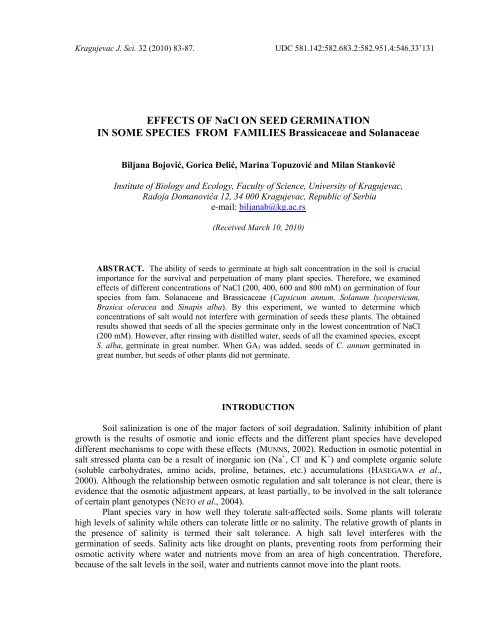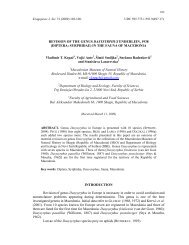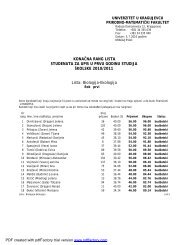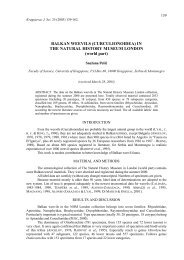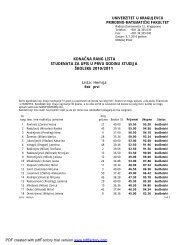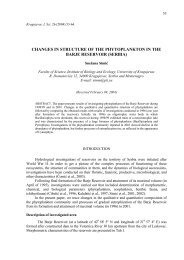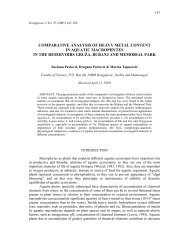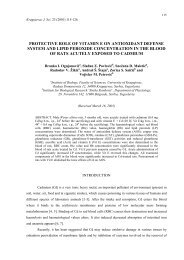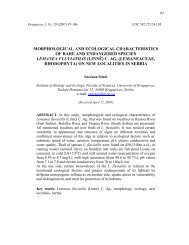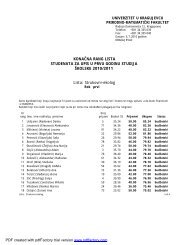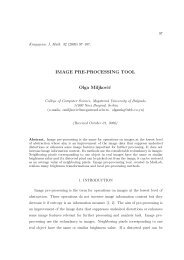EFFECTS OF NaCl ON SEED GERMINATION IN SOME SPECIES ...
EFFECTS OF NaCl ON SEED GERMINATION IN SOME SPECIES ...
EFFECTS OF NaCl ON SEED GERMINATION IN SOME SPECIES ...
You also want an ePaper? Increase the reach of your titles
YUMPU automatically turns print PDFs into web optimized ePapers that Google loves.
Kragujevac J. Sci. 32 (2010) 83-87. UDC 581.142:582.683.2:582.951.4:546.33’131<strong>EFFECTS</strong> <strong>OF</strong> <strong>NaCl</strong> <strong>ON</strong> <strong>SEED</strong> GERM<strong>IN</strong>ATI<strong>ON</strong><strong>IN</strong> <strong>SOME</strong> <strong>SPECIES</strong> FROM FAMILIES Brassicaceae and SolanaceaeBiljana Bojović, Gorica Đelić, Marina Topuzović and Milan StankovićInstitute of Biology and Ecology, Faculty of Science, University of Kragujevac,Radoja Domanovića 12, 34 000 Kragujevac, Republic of Serbiae-mail: biljanab@kg.ac.rs(Received March 10, 2010)ABSTRACT. The ability of seeds to germinate at high salt concentration in the soil is crucialimportance for the survival and perpetuation of many plant species. Therefore, we examinedeffects of different concentrations of <strong>NaCl</strong> (200, 400, 600 and 800 mM) on germination of fourspecies from fam. Solanaceae and Brassicaceae (Capsicum annum, Solanum lycopersicum,Brasica oleracea and Sinapis alba). By this experiment, we wanted to determine whichconcentrations of salt would not interfere with germination of seeds these plants. The obtainedresults showed that seeds of all the species germinate only in the lowest concentration of <strong>NaCl</strong>(200 mM). However, after rinsing with distilled water, seeds of all the examined species, exceptS. alba, germinate in great number. When GA 3 was added, seeds of C. annum germinated ingreat number, but seeds of other plants did not germinate.<strong>IN</strong>TRODUCTI<strong>ON</strong>Soil salinization is one of the major factors of soil degradation. Salinity inhibition of plantgrowth is the results of osmotic and ionic effects and the different plant species have developeddifferent mechanisms to cope with these effects (MUNNS, 2002). Reduction in osmotic potential insalt stressed planta can be a result of inorganic ion (Na + , Cl - and K + ) and complete organic solute(soluble carbohydrates, amino acids, proline, betaines, etc.) accumulations (HASEGAWA et al.,2000). Although the relationship between osmotic regulation and salt tolerance is not clear, there isevidence that the osmotic adjustment appears, at least partially, to be involved in the salt toleranceof certain plant genotypes (NETO et al., 2004).Plant species vary in how well they tolerate salt-affected soils. Some plants will toleratehigh levels of salinity while others can tolerate little or no salinity. The relative growth of plants inthe presence of salinity is termed their salt tolerance. A high salt level interferes with thegermination of seeds. Salinity acts like drought on plants, preventing roots from performing theirosmotic activity where water and nutrients move from an area of high concentration. Therefore,because of the salt levels in the soil, water and nutrients cannot move into the plant roots.
lycopersicum were germinated in 600 mM <strong>NaCl</strong>, while in the highest concentration of 800 mMseeds of any plant species did not germinate.85120100% germination806040Distilled water200mM <strong>NaCl</strong>400mM NaC600mM NaC800mM NaC200Sinapis albaBrassicaoleraceaCapsicumannumSolanumlycopersicumFig. 1. Seed germination in distilled water and <strong>NaCl</strong>After rinsing with distilled water, seeds of S. lycopersicum and C. annum germinated ingreater number from all of used concentrations of <strong>NaCl</strong> (Figure 2). Seeds of B. oleracea germinatedin smaller number, while seeds of Sinapis alba did not germinate.1009080% germination7060504030Distilled water200mM <strong>NaCl</strong>400mM NaC600mM NaC800mM NaC20100Sinapis albaBrassicaoleraceaCapsicumannumSolanumlycopersicumFig. 2. Seed germination after rinsing with distilled waterFigure 3 showed effect of gibberellic acid on seed germination. When GA 3 was added, seedsof C. annum germinated in great number, seeds of S. lycopersicum significant smaller (under 5%),but seeds of other plants did not germinate.
863530% germination252015105Distilled water200mM <strong>NaCl</strong>400mM NaC600mM NaC800mM NaC0Sinapis albaBrassicaoleraceaCapsicumannumSolanumlycopersicumFig. 3. The effect of gibberellic acid on seed germinationDISCUSSI<strong>ON</strong>Plants display great diversity with regard to soil salinity tolerance. Species distribution andsurvival mainly depend on the seed ability to complete germination and the seedling ability todevelop successfully under unfavorable conditions (ŽIVKOVIĆ et al., 2007). Most seeds are locatednear the soil surface. Salt concentration in the soil surface changes over time. Continuous waterevaporation causes surface salt deposition (UNGAR, 1991), while rain dissolves and washes awaysalt deposits and provides enough water for germination. In the course of evolution, seeds haveadapted to such changes, staying viable at high soil salinity and being able to germinate underappropriate external conditions (KHAN and UNGAR, 1997).The groups of plants that are well adapted to saline habitats are called halophytes. Theirseeds germinate well in freshwater and the germination is similar to that of seeds of non-adaptedspecies. However, they differ from them in ability to germinate at higher salt concentrations in thesoil. Salinity tolerance of many perennial halophytes dependant on a variety of abiotic factors(BASK<strong>IN</strong> and BASK<strong>IN</strong>, 1998).Our preliminary results showed that seeds of S. alba, B. oleracea, S. lycopersicum and C.annum germinated at low concentrations of <strong>NaCl</strong> (200 mM), while at higher concentrations seedsthese species were inhibited. Although species from families Solanaceae and Brassicaceae are nottypical halophytes, their seeds germinated well at a moderately elevated salt concentration.However, none of seeds germinated if kept in concentrations of 400, 600 and 800 mM of <strong>NaCl</strong>.However, these seeds remained viable, and after rinsing with distilled water and transferred inmedium free of <strong>NaCl</strong>, they germinated in significant number (except seeds of S. alba). Publisheddata show that the effect of <strong>NaCl</strong> on seed germination is mostly osmotic (LOERCHER, 1974;REYNOLDS, 1975), but the nature of its effect is unknown.It is known that the effect of salts on plants leads to physiological drought. It can beconcluded that salt reduces the water potential of soil solution, which prevents the supply of waterby plants. They in the salty soils receiving large amounts of salt in root cells, and thus reduces thewater potential, so it increases the absorption of water in physiological drought conditions.
87References:[1] BAJJI, M., K<strong>IN</strong>ET, J-M., and S. LUTTS (2002): Osmotic and ionic effects of <strong>NaCl</strong> on germination,early seedling growth and ion content of Atriplex halimus. Can. J. Bot. 80, 297-304.[2] BASK<strong>IN</strong>, J. M. and C. C. BASK<strong>IN</strong> (1998): Seeds: Ecology, Biogegraphy and Evolution ofdormancy and germination. Academic Press, San Diego, Calif. U.S.A.[3] HASEGAWA, P. M., BRESS<strong>ON</strong>, R. A., ZHU, J-K., BOHNERT, H. J. (2000): Plant cellular andmolecular responses to high salinity. Annu. Rev. Plant Physiol. Plant Mol. Biol., 51, 463-499.[4] HAWADA, A. M. (1994): Alleviation of the adverse effect of <strong>NaCl</strong> on germination of maizegrains by calcium. Biologia Plantarum, 20, 623-627.[5] KHAN, A. M., RIZVI, Y. (1994): Effect of salinity, temperature and growth regulators on thegermination and early seedling growth of Atriplex griffthii. Can. J. Bot., 72, 475-479.[6] KHAN, A. M. and I. A. UNGAR (1997): Effect of thermoperiod on recovery of seed germinationof halophytes from saline conditions. Am. J. Bot., 84, 279-283.[7] LOERCHER, L. (1974): Persistence of red light induction in lettuce seeds of varying hydration.Plant Physiol. 53, 503-506.[8] MUNNS, R. (2002): Comparative physiology of salt and water stress. Plant Cell Environ, 28,239-250.[9] NETO, A.D., PRISCO, J. T. and ENAS-FILHO, J. (2004): Effects of salt stress on plant growth,stomatal response and solute accumulation of different maize genotypes. Brazillian Journal ofPlant Physiology, 16, 591-596.[10] REYNOLDS, T. (1975): Characterization of osmotic restraints on lettuce from germination. Ann.Bot., 39, 791-796.[11] UNGAR, I.A. (1991): Ecophysiology of Vascular Halophytes. CRC Press, Boca Raton, U.S.A.[12] ŽIVKOVIĆ, S., DEVIĆ, M., FILIPOVIĆ, B., GIBA, Z. and GRUBIŠIĆ, D. (2007): Effect of <strong>NaCl</strong> onseed germination in some Centaurium Hill. species (Gentianaceae). Arch. Biol. Sci., 59 (3),227-231.


